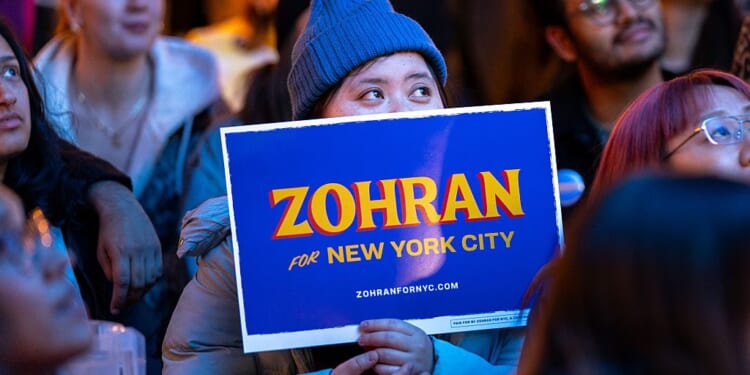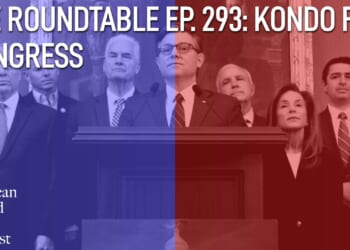Last year, something peculiar happened in Corona, Queens. In this Hispanic-majority neighbourhood of New York, where signs reading “Aceptamos food stamps” adorn storefronts and Jesus figurines perch on front porches, voters delivered one of the city’s sharpest swings to Donald Trump. But then, on 4 November this year, the neighbourhood snapped back, opting instead for the 34-year-old Democrat socialist Zohran Mamdani. What happened?
Back in 2024, the President’s gains in neighbourhoods like Corona were widely taken as evidence of a new Republican coalition: multi-racial, working-class and culturally conservative. But with Mamdani’s victory, that coalition appears to be under threat. For not only did these voters abandon the Republicans, they spurned the moderate choice, Andrew Cuomo, too. In fact, Mamdani made significant inroads with the very electorate that propelled Trump to victory just 12 months ago.
There were an estimated 60,000 New Yorkers who voted for Trump and Mamdani. In a city of eight million, that may not seem like much, but they exemplify a broader trend across the country. As this month’s special elections showed, America’s non-white population is becoming ideologically promiscuous, flitting between both major parties, and shedding long-standing partisan loyalties in the process. When I visited some of the neighbourhoods where the Trump-Mamdani swing was most pronounced, the overall message was clear: the status quo was not working. With next year’s midterms looming, this restless, unpredictable bloc could prove decisive in shaping the balance of power in Washington.
Here in New York, sandwiched between La Guardia airport and the Mets’ baseball ground, Citi Field, is Corona, one of the most Hispanic corners of the city. Next to Flushing Meadows-Corona Park, the streets are lined with vendors selling roasted corn, fresh tamales, mangoes, and empanadas. The residents, mostly first- or second-generation immigrants from Latin America, are blue-collar, Catholic and entrepreneurial, with many working two jobs, or sometimes three.
In 2024, Trump won six election districts here (up from zero), and made double-digit percentage point gains in dozens of others nearby. It was the best performance of any Republican nominee in Gotham since 1988, fuelled by anger over rising grocery prices, the cost of living, and declining public safety. But within a year, voters turned away from the 79-year-old, two-term president and voted for the 34-year-old newcomer Mamdani instead.
“Trump brought too much chaos, man,” says Ramon*, whom I met outside the Guatemalteca Deli on Roosevelt Avenue. “My bills are still high and my wife can’t afford no groceries.” A part-time car mechanic by day and cleaner at the new JP Morgan office by night, Ramon says that he voted for Trump in 2024 because he thought he’d bring down the price of gas and groceries, but “that ain’t happened”. “I don’t know if Mamdani’s going to make things better or worse,” he said, “but we need something different from this.”
The despair felt by Ramon wasn’t confined to Roosevelt Avenue. Ten minutes north of Corona lies East Elmhurst, another Queens neighbourhood that saw a similar Trump-to-Mamdani swing. Unlike Corona, there is no subway line here, and the Manhattan skyline barely pokes out in the distance. At the local park, I spoke with Carlos de Cruz, who told me that he didn’t vote this month, but said that many of his friends followed Ramon’s lead. “They wanted something different with Trump,” he said. “Now they’re angry with him because the prices are still high. The ICE stuff is scary. Now they think Mamdani will bring something different.”
Mamdani certainly is bringing something different. He has promised free buses, free universal childcare, public grocery stores, a $30 minimum wage, and a rent freeze for roughly one million rent-stabilised units in the city. It’s a platform that jives well with New York’s “commie corridor”, which stretches from northwest Queens down through Brooklyn, but it took longer for the city’s outer boroughs to warm up to it. When Mamdani won the Democratic primary in June, he did so without much support from the city’s immigrant and working-class communities. But by the mayoral election this month, he built a rainbow coalition of Muslim, black, and Hispanic voters as well as renters and progressives.
Bronx local Yahay Obeid is a new member of this rainbow coalition. A two-time Trump voter, the air traffic controller was so “disgusted” by the racism he saw on the Right that he ended up voting for him. “There are a lot of people like me who are not socialists,” he said. “They are moderates who found the racial slurs and racist bigotry so disgusting and disturbing that they decided to vote for Mamdani.” Then why, I ask, not vote for Cuomo? “Cuomo shut down houses of worship during Covid and I’ll never forgive him for that.”
Obeid, the director of the Bronx Muslim Center, is a practising Muslim. He admitted that many in his community had reservations about Mamdani, particularly over his liberal positions on prostitution and public safety. Previous statements including “defund the police” and describing the NYPD as “racist, anti-queer & a major threat to public safety” had unnerved his members. That was, until, Mamdani met with them on several occasions to assuage their concerns. “We were getting backlash that he wanted to legalise prostitution,” Obeid said. “But he told us that was DSA (Democratic Socialists of America) policy, not his. We also asked him about defunding the police, but he said that he’s not looking to cut down on police and that he’s keeping the same police commissioner, so that changed the mood in the room.”
In 2024, Trump claimed roughly 30% of the Muslim vote nationally. But in this month’s election, Mamdani secured around nine out of every 10 of New York’s Muslim votes. He did this by leaning into his Islamic identity, producing campaign videos in Urdu and Bangla, and fusing it with an economically populist message. In one of his earliest (and most popular) campaign videos, for example, he railed against “Halalflation”, a nod to rising street‑food prices, which quickly spread through WhatsApp groups and local mosque networks.
“Mamdani understands the difference between ethnic politics and identity politics,” said Renu Mukherjee, a fellow at the Manhattan Institute. “There was no grievance — he just immersed himself in various local cultures, which Cuomo completely failed to do.” That was evident when Mamdani took the unusual step, for a non-Latino candidate, of releasing a full Spanish-language ad. And it was evident when I visited Jamaica Hill, central Queens, where stray Mamdani flyers in Bangla fluttered past bridal shops selling affordable saris and sherwanis.
Last year, Jamaica Hill swung nearly 25 points towards the GOP last year, only to flip to Mamdani by an even larger margin. In several districts, he captured more than 70% of the vote, highlighting the success of his outreach campaign. But there was also something simpler at work: many voters saw him as one of their own, a sense that only deepened as Right-wing attacks intensified. In one notorious case, Mamdani was attacked online for eating rice with his hands, with one GOP Congressman telling him to “go back to the Third World”. Except when I stopped for lunch at Khalil Biriyani House, at least half of the customers were doing the same.
Clearly, he was more in step with the neighbourhood than his critics were. New York has long had a large foreign-born population, but unlike other multicultural cities such as London, it is far less assimilationist. Here, many immigrant communities remain distinct, as evidenced by the 40+ ethnic enclaves across the city. Harlem has “Le Petit Senegal”; Queens has “Little Manila”; and in the Bronx, where Obeid lives, there is a little Yemen. In recent years, however, assimilation has slowed further, driven in part by the arrival of new immigrant groups, such as Bangladeshis. In the Jamaica district, where the South Asian population has exploded, new arrivals have brought cultural habits from their countries of origin — such as eating rice with hands — which Mamdani himself mirrored.
The interesting question this all poses is whether Mamdani’s brand of ethnic politics can lay a template for Democrats elsewhere. Despite his campaign’s strengths, it was also clear that a strong anti-incumbent feeling drove many New Yorkers to “vote blue no matter who”. Fear and fury over high grocery prices, a needlessly showy deportations campaign, and cuts to Medicaid and SNAP have turned voters against Trump. “There was definitely an anti-Trump backlash in some of these neighbourhoods,” said Michael Lange, author of the Narrative Wars Substack. “If Kamala Harris and Trump reran this year, Trump isn’t winning neighbourhoods like North Corona or others in Queens.”
But Democrats have also found limited success running as the perma-scandalised anti-Trump party, a strategy that minority communities, as 2024 demonstrated, do not respond well to. As a result, these voters — who are more pragmatic than ideological — remain up for grabs, which helps explain why some of the biggest shifts in these special elections occurred among the country’s non-white population. For example, New Jersey’s two counties with the biggest moves towards Democrats had the largest concentrations of Hispanics. Meanwhile in Virginia, Hispanic and Asian voters swung 20 and 42 points, respectively, towards the Democratic governor’s candidate compared with the 2024 presidential election. Taken together, these results show that non-white voters are far from a captive electorate.
This presents a problem — and opportunity — for both parties. Over the past decade, Democrats have become whiter, wealthier, and more college-educated, increasingly orientated toward suburban and professional constituencies. That shift has alienated the non-white, working-class voters who once formed the backbone of the party’s coalition. But as shown by the election successes of Mamdani, Mikie Sherill (New Jersey’s governor-elect) and Abigail Spanberger (Virginia’s governor-elect), a renewed focus on affordability can at least work some way towards restoring some of that lost trust.
Mamdani’s focus on economic, rather than cultural, grievances was a vindication of this strategy. In the early 2020s, the then Queens assemblyman’s views were a grab-bag of BLM politics: Covid maximalism, defunding the police, ending capitalism, and promoting racial identitarianism. By contrast, his campaign focused on New York’s cost of living crisis and extending an olive branch to Trump voters. Similarly in Virginia, more than half of all the GOP’s political ads were about trans issues, which did not strike a chord with voters struggling to pay their electricity bills.
For Trump and the Republicans, the warning is just as stark. The same results show that they do not have as strong a grip on these voters as once thought. With the midterms less than a year away, any overreliance on Trump’s prior popularity risks undoing the gains Republicans made with Latino and Asian communities. In states such as Texas, where Republican gerrymandering relied heavily on Trump-era support among Latino voters, at least two seats may now be in jeopardy. Given that Latino voters are more likely than any other ethnic group to cite the economy as their top concern, improving the health of the economy has to become a central focus of the Trump administration.
Next year’s elections, then, could shape up to be the most unpredictable yet. With a strong anti-incumbent sentiment spreading across the country, Democrats are well placed to capitalise on this voter disaffection. But if there’s one thing this party excels at, it’s snatching defeat from the jaws of victory. Should Mamdani fail to deliver on any of his ambitious promises, it could tarnish the Democratic brand for years. If public safety deteriorates or cost-of-living pressures rise, New York’s new mayor will become the embodiment of Democratic urban failure, a cautionary symbol for voters nationwide.
More broadly, the Trump-Mamdani overlap illustrates a wider trend: that American politics is becoming increasingly volatile, localised, and issue-driven, rather than strictly tribal. This shift is especially evident among immigrant populations, who lack the same kind of tribal loyalty to parties often found among white voters. The constant cycling between Democrats and Republicans suggests that there is now a widespread dissatisfaction with the status quo, creating a fertile political terrain for insurgent candidates like Mamdani.
Crucially, Mamdani represents the beginning, not the end, of this insurgency. In other blue cities, progressives and socialists are gaining ground, with New York’s mayor-elect serving as a blueprint for their campaigns. But the lessons of the early 2020s should not be forgotten: veer too far into cultural politics and you risk alienating the very voters who put you in office. It was, after all, the former cop and moderate Eric Adams who replaced the progressive mayor Bill de Blasio in New York’s last mayoral election.
At a state and federal level, voters have shown they are willing to buck party allegiances if there is something new on the table. Paradoxically, they are voting for change in the hope of returning to some semblance of normality. As Ramon succinctly put it: “The world is crazy right now… I just want to get on with my life.”
*Ramon’s name was changed

















